After the bone biopsy came back positive for infection, which was 2 weeks after surgery (for this type of bacterium, the cultures take that long), I started an aggressive course of IV antibiotics immediately. The doctor prescribed 6 weeks of Rocephin (ceftriaxone) as a good bet to destroy the infection deep in the bone. This antibiotic is given once a day, every day, through a Peripherally Inserted Central Catheter (PICC) line. Warning: there are some ugly PICC line pictures in the post below.
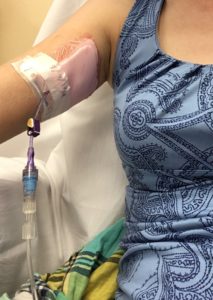
I cancelled a long-planned vacation and settled in to PICC life. There are many, many webpages and youtube videos dedicated to helping new PICC-liners adjust to having it in and giving tips about how to go about daily life with a catheter coming out of your upper arm. Many of these folks, including children and teenagers, have had lines in for months or years for chronic illness and I am just in awe of their resilience and fortitude. I had mine for only 6 weeks for an acute problem, and as of two days ago, it is OUT and done.
In any case, if you are also getting a PICC line, there are two main (I hope) useful pieces of information for you readers from this long and rambling post about my experience with it:
- The PICC line arm for me was pretty hard to use for at least a few days to maybe a week after insertion. I ended up needing a lot more help than I thought I would, since I assumed it wouldn’t be that bad. Be prepared to have an impaired arm for a little while.
- If your skin is reactive to adhesives, don’t suffer through a dressing that is uncomfortable; keep asking for changes to the system until you find one that works.
Although there is already tons of internet text describing peoples’ experiences with PICC lines, I found it helpful to know I wasn’t alone when weird things happened, and I wondered multiple times about going to the ER when things didn’t seem normal. Heart palpitations, rashes, blistering, stabbing pain at the insertion site, mild pain up along the PICC line path—all of those things happened in 6 short weeks that felt like a lot longer. In my case none of them turned out to be emergencies or serious complications, thank goodness.
The worst part of having the PICC line for me was that they put it into my *good* arm (righty)—my bad arm (lefty) had just had surgery 2 weeks before. That meant I immediately had two impaired arms, although lefty was technically cleared to do stuff because the surgery was not extensive. But until the PICC line insertion pain in righty settled down, I had to switch immediately to doing everything with lefty (which may have been good for post-surgical recovery, I don’t know); but it was hard and very painful. I just say this because IF you are going to end up with both arms out of commission it is good to be prepared. Carrying groceries was impossible at first, for example. (Note that you are not supposed to lift anything heavier than 10 lbs with the PICC line arm.) Even driving hurt the PICC line arm. After the first week or so, this all got much better.
I’m one of the many unlucky people who have a bad skin reaction to the adhesives and chemical cleansers used under the PICC line dressings. (I already knew my skin was sensitive because the adhesives in band-aids and kinesiotape give me skin trouble.) I was grateful for all the information on the web from people who tried different combinations of materials, so here is my experience. The dressing used on the first day (a Tegaderm product) caused my skin to blister. The second day, they switched it out for another type of dressing, but that type didn’t have a “wing guard,” and the plastic itself (or the plastic plus ChloraPrep plus adhesive) reacted badly against my skin and was quite uncomfortable:
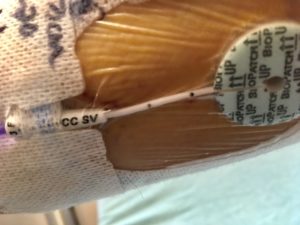
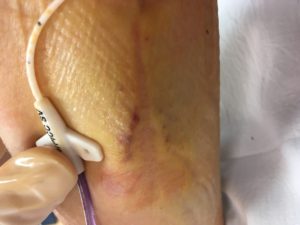
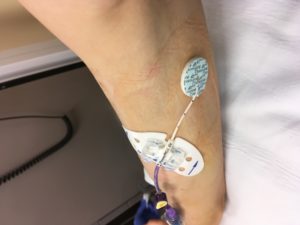
This was just my first week with the PICC line so I wasn’t sure how much discomfort I should be in; I told the nurses every day that I felt “like sawing my arm off,” but no one moved to make a dressing change for days, so I figured it must be normal. Finally I got a dressing change one day before the scheduled date, and I felt so much relief I could not believe that we didn’t do it sooner. Moral: if you feel like sawing your own arm off, there is probably a better dressing solution out there for you. If no one offers, you should ask for it.
I asked the PICC nurses if there is a type of dressing that is uniformly hypoallergenic, that even the most reactive skin types don’t blister and rash up from. I was told that everyone is so different, it’s just a matter of experimentation, unfortunately. This time they applied the ChloroPrep but then wiped it off with alcohol, let that dry, applied Cavilon spray, let THAT dry, and then dressed it. This third dressing that we tried was much, much better. It’s made by Allevyn. The problem is that the adhesive is not very strong, and it peels away, so it needs to be secured with paper tape.
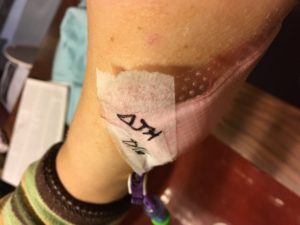
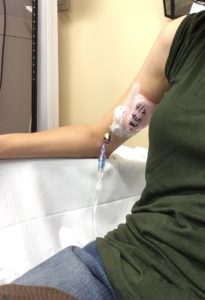
The cover they gave me at the hospital to go over the dressing was also seriously uncomfortable (itchy and tight). The PICC line nurses recommended cutting up a clean sock and using that instead—I agree, it was way more comfortable (and potentially stylish, depending on what old sock you use…)

Just as I got the dressing discomfort sorted out after week 1, I started having an allergic reaction to the antibiotic. It was a full-body rash that occurred as my sensitivity to the Rocephin began to build up. After a few days of trying to manage it with Benadryl and other allergy drugs, we gave up on the Rocephin and switched to a different antibiotic, Invanz (ertapenem), which fortunately I was not allergic to.
As for other PICC line-specific side effects, the heart palpitations were something I never felt quite comfortable with. It sounds like they are a pretty common side effect, especially if the PICC line goes too close to the heart, but obviously you should seek an actual medical opinion if you are having this problem. The first night after the PICC line was inserted, the heart fluttering feeling was the worst (especially when laying down), and the next day they pulled the catheter out a little bit (1 cm) and the sensation stopped happening so often. But whenever I took a deep breath I felt something abnormal, hard to put my finger on, just…weird.
Because of the weird sensations in my chest, and the necessity of not getting the dressing wet, and the fact that it was really hard to shower, I opted not to do any strenuous exercise while I had the PICC line, but if I had been on the line for longer that would not have been an option. I really, really miss getting outside and exercising….not to mention that dialing back your activity may have persistent consequences that are hard to bounce back from. However, I realize that for some people with PICC lines due to chronic illnesses, exercise isn’t always possible and I am so grateful that I have the good fortune to be able to return to some kind of sport.
——
I keep getting asked if my injured arm is all better now that the course of antibiotics is over, and I always explain what was explained to me, which is that the microbiological resolution comes first (killing the bone infection) and then the bone damage, or in this case osteomyelitis, will take more time to heal, on the order of a couple of months, typically. For now, lefty doesn’t feel significantly better than before the surgery and antibiotics, but I’m very optimistic. It has been 8.5 months since the flu shot. I might also be able to start climbing soon, especially knowing that the ongoing pain isn’t rooted in soft tissue that can be further damaged by activity but is from edema in the bone. One step at a time. I will be very happy if this all resolves inside of a year.
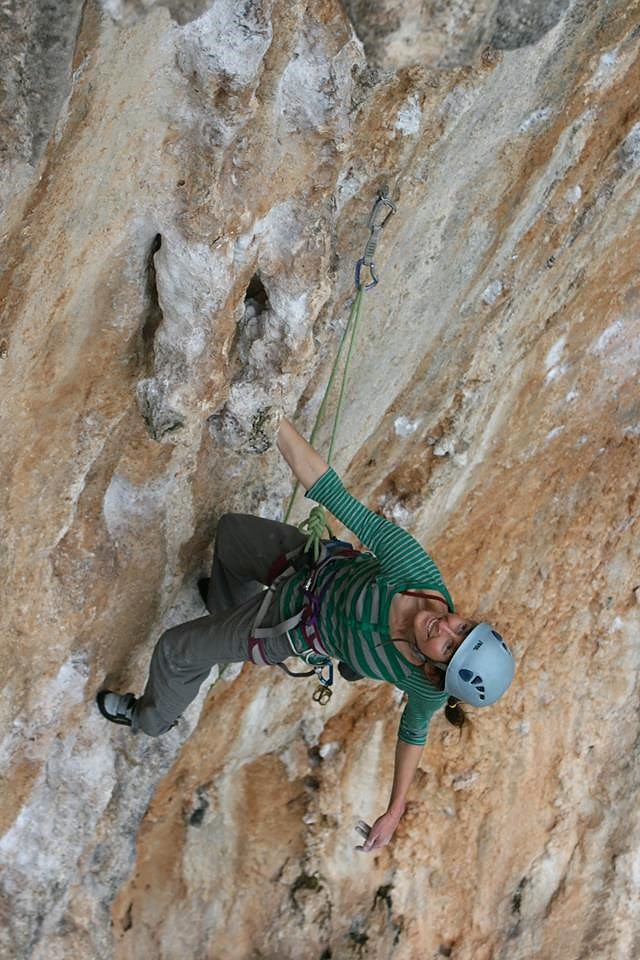
Thank you for writing this. I am on my 2nd picc line for osteomyelitis. The first one was for two weeks. Manageable. This one could be for up to 6 months however and I am trying to find ways to be comfortable. I love the sock idea and will be trying this too.